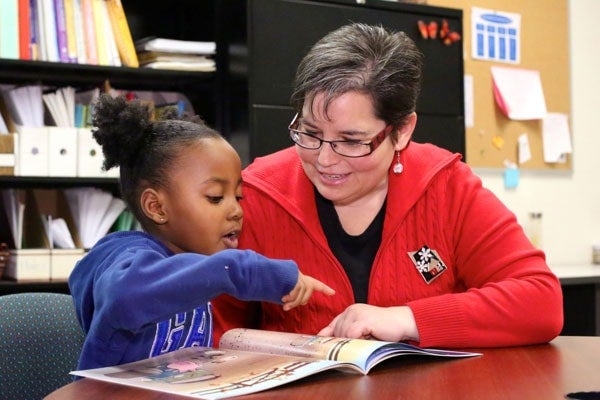
Literacy secrets: understanding how children learn to read
Published: November 27, 2013
What are the best ways to promote literacy in children? As an early literacy specialist who taught parents and preschool teachers, Trelani Milburn answered that question many times.
During nine years of community work in Southern Ontario, Milburn used techniques such as face-to-face interaction with infants and linking stories to events in children’s lives when reading to them. But she sometimes had trouble answering another question: “What evidence supports the advice I’m giving?”
This second question inspired Milburn to go back to school in 2007, more than 20 years after she first became a student at the University of Toronto Scarborough. She finished an undergraduate program part-time then upgraded it to an honours degree in psycholinguistics. Milburn started graduate school the day her youngest child began his undergraduate program.
Milburn is now a third-year PhD student in the Child Language Lab run by Luigi Girolametto, a professor in the Department of Speech Language Pathology. She studies emergent literacy — the foundational skills that enable children to begin to read and write — such as vocabulary, storytelling, and letter and sound recognition.
She no longer wonders what evidence informs child literacy — she creates it.
“There is a delicate interplay between children and adults. If we can better measure what works, we can improve the literacy of all children, and intervene more effectively to help those at risk of falling behind,” says Milburn.
“Shared reading” is one way adults can build literacy in all kids, while limiting risk for those who face major learning challenges. Parents and teachers can learn to engage children in conversation with open questions and responsive statements, rather than reading books cover-to-cover. This interaction can enhance a child’s understanding of and ability to use language.
But there is not a lot of evidence that shows exactly why, or how well, shared reading works.
Milburn and her colleagues recently developed a system to measure shared reading, and to show whether it increases conversation between kids and adults. They divided educators into two groups, and trained one group in shared-reading techniques. Then they video-recorded the educators reading to their kids, and tracked the number of open questions, variety of words and “turns” in each conversation.
“I can say emphatically that professional development changed the educators’ interactions with children,” says Milburn, the lead author on the study, which will appear in the Journal of Early Childhood Literacy. “We saw a statistically significant difference between the groups in a naturalistic context, and because of the strength of the study design — this was a randomized, controlled study — we’re confident the results will translate to other classrooms.”
Girolametto has helped move several findings from the Child Language Lab into the classroom, through long-standing relationships with community organizations. For eight years, he worked at the Hanen Centre, which educates thousands of parents, educators and speech language pathologists around the world.
“It often takes a decade or more for research to change real-world practices,” says Girolametto. “But the Hanen Centre can disseminate new knowledge as we create it and improve literacy practices right away.”
Girolametto says Milburn is also well-positioned to make an impact on the lives of children, given the professional relationships she built before returning to school. And, she is still asking questions.
“Trelani has a very curious mind,” he says. “It’s what led her back to school, and keeps her asking fresh questions of the data, which is great for our lab.”
Jim Oldfield is a writer with the Faculty of Medicine at the University of Toronto.



